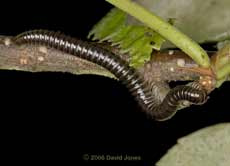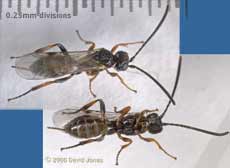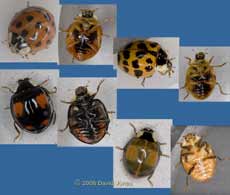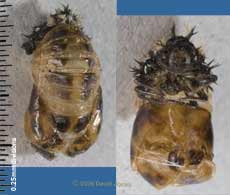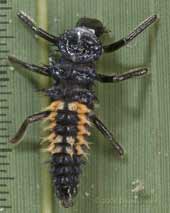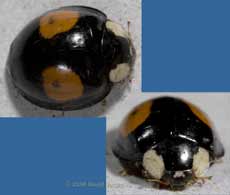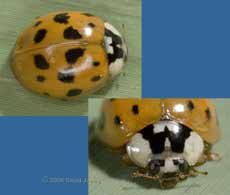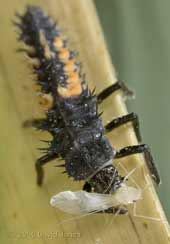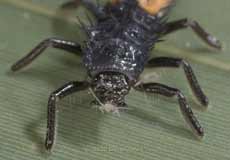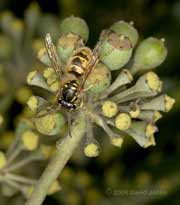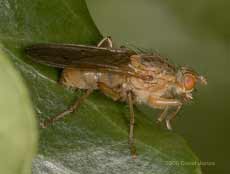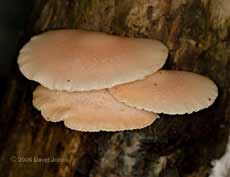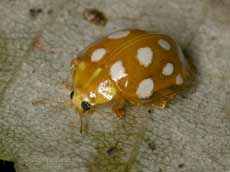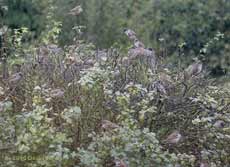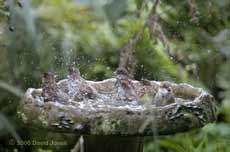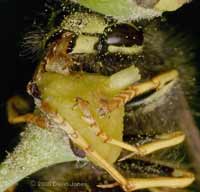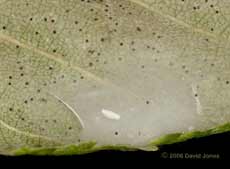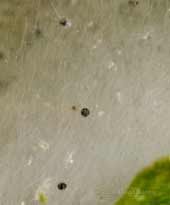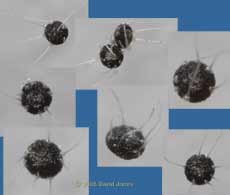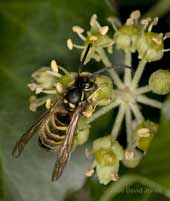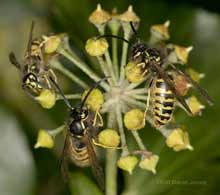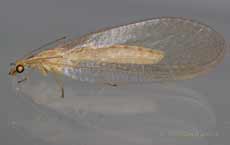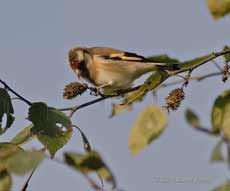Go to the last entry on this page .....Go to previous entry22 October - Over the last couple of days it has been getting slightly cooler (maximum temperatures around 16-17C), with sunny periods and some rain on the 20th. This morning it is completely overcast at 8.30am and the forecast is for rain today. The last couple of days have been largely cancelled for me as the CFS kicks in again - it's very frustrating. I'm starting off this morning, feeling as though I've already been doing hours of hard physical work and all I've done is make a cup of tea! Anyway, back to the garden, where Autumn is arriving at last. The ground under the Hawthorn is now decorated with dull, yellowish leaves from the tree, and the covering is being added to every time the sparrows bounce around in the branches. At the other end of the garden, the birch is also starting to shed its foliage. In that case, while some of the fallen leaves have changed colour, the Birch also sheds leaves that are still completely green. Mild night-time temperatures (not dropping below 11C) mean that there is hedgehog activity in the garden. I saw one the night before last and there are fresh droppings here this morning.
There is just this one picture from two nights ago. While I sometimes come across millipedes when I turn stones over, I don't usually come across them up in the Birch tree
Despite my comments about the Ivy nearing the end of its flowering, it has been a very busy place the last couple of days, with the wasps appearing to be in the majority amongst the visitors. I didn't see any Red Admirals yesterday (it was quite breezy) but there were three about on the 20th, when I also caught another glimpse of a Hornet. The last couple of days have seen several visits by the local Sparrowhawk female. I didn't see her catch anything. On the 20th I heard the familiar (from our times in Cornwall) call of a Buzzard as it soared high overhead - the second time we we've seen here this Autumn. The Goldfinches and Blue Tits continue to visit regularly, and after a bit of a gap the Great Tits have stared to come to the feeders again. I even saw a Wren on the bird table on the 20th. After a long gap (since early summer) there is a male Blackbird about, coming several times to our Pyracantha to enjoy the berries. We will have to wait and see whether this is just a winter visitor from the continent or a new resident. The same is true for the Robin that has also appeared over the last few days, and which 'bubbles' its way through its quiet sub-song in the hawthorn. Although we have seen Dunnocks here occasionally over the last couple of months, its only in these last few days that one has again been spending a lot of time on the ground here. Up to now, all our garden waste has been taken to the local recycling centre to be turned into compost, but that will no longer happen. Last week I decided that I could squeeze a composting bin into the space between the water butt that stores the rainfall collected from the caravan shelter, and the big bamboo plant in front of my workshop shed. The first 'deposit' was made on the 20th! The rain soon arrived this morning, and for the rest of the day it was very wet here. There was no chance of taking the camera outside so I brought a couple of insects into the house from the Hawthorn.
The first was this sawfly which is very similar to ones I see quite often on the birch when I check it at night. I'm not able to get close to identifying it.
This second insects is similar to one of the Barkflies that I've already photographed (14 October) although there appear to be slight differences in the markings, and this one has fewer dark areas on the wings.
This afternoon we went to one of our sons and his partner (in Farnborough, a couple of miles to the North of us). After a very nice meal, they commented on the number of ladybirds that they were seeing both outside and inside their house, and we went into their conservatory to find examples - they were all Harlequin Ladybirds! They have a large Sycamore tree overhanging their property at it seems that it has lots of aphids on it, and as a consequence, a large population of these ladybirds. It seems that the single example is just a 'scout' for the main force which is almost on our doorstep!
Here are four examples to show the variation in patterns, with the underside of each included. The bottom-right image is of a newly emerged adult. When I collected it, the colour was all a dull orange yellow. The picture was taken several hours later. Eight hours later the elytra (wing cases) is almost black with just two large red spots - I will photograph it again tomorrow.
As I've just said, that individual was newly emerged, and there were a number of empty pupal cases to be seen, with a very spiky moulted skin at one end.
If the pupal cases weren't enough of a surprise, then what should appear next was this very active larva (pictured here on a bamboo leaf). Its very spiky exoskeleton gives it a formidable appearance. It is now in captivity, and I hope to provide a supply of aphids until it pupates.
24 October - A really dismal morning. It's not raining at present, but there is very low cloud and light levels are low at 10am. Not even the colours of 14+ Goldfinches that have been feeding here have been able to brighten things up! The warm temperatures that had stayed with us through the first half of the month are now giving way to cooler conditions, with the temperature peaking at 15C on the 22nd, and just 13C yesterday. At 12.30am today it is just 11C. However, the sun has just come out so it could well get a bit warmer this afternoon - at least the Goldfinches look bright again, and they have just been joined at the feeders by a Greenfinch, a welcome, occasional visitor. A technical hitch prevented me from adding anything to the diary yesterday, and the weather wasn't conducive to using the camera outside, but I did take a couple more photographs of the Harlequin Ladybirds which I think are worth adding to the collection.
First, the individual which was photographed a few hours after emerging on the 22nd - this is what it looks like now. No two of the twelve Harlequins that I've collected so far have identical colour patterns. but while most show just moderate variations, this is the only one that I've seen so far with this colour pattern variation, with a spot within a spot arrangement. I believe it is referred to as H. axyridis conspicua. This second one, at a first glance, couldn't appear more different. In this case, the variant is H. axyridis succinea As far as the colour schemes are concerned it seems that the only characteristic they only have in common are the white 'cheeks' of the pronotum (the visible area of the thorax that protects the head). The white colouring continues around all the underside of the thorax - you can see this in the pictures from the 22nd. Although they don't really show in these pictures, the legs and antennae of all the Harlequins are all brown in colour. There is also something else that I don't think I've noticed on other, native ladybirds. Very close to the rear end of the elytra (wing covers) there seems to be indentations visible on both of these individuals and on the others that I have already photographed. below each 'dent' there is a definite horizontal ridge formed.
While I write this, the Harlequin larva is busy working its way through a feast of aphids served up on a yellowing bamboo leaf.
While it seems to move about in a random way, the wide spread of the front legs, together with their hairy undersides, seems to act like a fishing net, and any aphid unfortunate to touch the legs is swept quickly to the mouth.
The voraciousness with which it is devouring the aphids gives an indication why this species has been exploited as a biological control. It is far more aggressive than other ladybird larvae that I've watched here in the garden, a characteristic that may well spell disaster for our native Ladybirds. Just a note to say that I've added a couple of paragraphs to the 20D introduction in the technical section of the diary. During the winter months I hope to do some more work in that bit of the website. Late afternoon sunshine encouraged me to head up the tower to check the Ivy. It is a lot quieter today and this time I think it's safe to say that flowering is coming to an end.
Over the top of the Ivy I can see very few flowers that still have anthers, and many flower-heads are now expanding into the berries that will ripen after Christmas. Insect numbers were noticeably down on last week and today it was the wasps that were the most numerous. There were some flies about, but in the half hour or so that I watched I saw no hoverflies at all.
There was one late-comer to the party. This is the first dung-fly that I have seen here this Autumn, and the lack of other insects about may mean it will have a long time to wait before it has prey to ambush.
Another look at the fungus that I first photographed on the 10th and then again on the14th October. The caps are now almost flat discs with the largest about 7.5cm across.
Tonight the sky is clear, and having got up to just 13C during the day, the temperature has dropped to below 9C by 9pm. I have just been to look at the Ivy and can see just one snail on the top of it, although the flowers lower down the plant and that still have anthers have numerous mosquitoes on them. A torchlight search of the Birch revealed very few insects of any description, but I did see a couple of Orange Ladybirds. This one is on the underside of a leaf (as usual) and in a 'field' of white mildew filaments. In the large image you will see the developing perithecia (see entry for 16 October). As I've said previously, it's disappointing to see so few of the Orange Ladybirds here this Autumn. I'm just hoping its just a temporary dip in the population (and one that the Harlequins will not have an effect on next year).
26 October - Topsy-turvy weather at the moment - Yesterday was largely dull and damp with a high temperature of around 14C, but during the night it reached nearly 16C. Now, at just after 11am it is about 15C and dry, with grey skies and occasional sunny periods. There was an item on the morning news about the demise of garden birds as more and more people cover over their gardens with patio areas and gravel. I often wonder about the extent to which our garden is similarly covered, but hopefully we have been able to make up for it with the cover we provide.
In this shot I can count at least 25 of them in just a portion of the tree top.
Neither is the birdbath used that frequently, but when a Sparrow does decide to use it, inevitably it becomes a social occasion. Just before I grabbed my camera to get this shot there were eight of them trying to bathe.
While for most of the time they seem to chirp (almost) in unison, there are inevitable squabbles over perches at the feeder, and, it seems, over which of the nest boxes they use to roost - they are back and forth to these throughout the day. In contrast to the Sparrow feeder, the Sunflower feeders are emptying fast at the moment, mainly thanks to the Goldfinches, but with some assistance from Blue Tits, sparrows, a Collared Dove, and the occasional Great Tit. It is still only an occasional sighting, but there was a female Blackbird feeding under the hawthorn this morning. I haven't see a male since I last mentioned one feeding on the Pyracantha three days ago. This afternoon we headed for Southampton airport so that one of our sons could catch a flight 'up north'. It was sunny for nearly all of the trip, in fact pleasant enough to bring the temperature here up to 18C, and at 5pm the skies are largely cloud free. There was a sad sight on the way home - a recently killed badger at the side of the road. At least it was the only road-kill we saw during the whole journey. By the time I was able to check the Ivy on our return, much of it was in shade. Insect activity was low, but I was able to count a dozen or so wasps at any one time, and smaller numbers of flies.
When I watch them, I usually get the impression that they are using their jaws to scrape the secretions off the flower head.
However, in this second picture you can see that the wasp can extend a soft mouth part, presumably to mop up the food, much as other insects do. This was the first time that I've managed to photograph a wasp with this 'tongue' extended. Notice how both wasps have been to flowers that are still producing pollen. These are few in number now.
27 October - A bright and almost cloudless morning, and noticeably cooler than yesterday. At 10.15am it is 9C after dropping down to below 6C at around 8am. It seems ages ago that the BBC team came to visit in early September, but the Shared Earth programme is being broadcast this afternoon, and the 'chat in the garden' forms the middle portion of the programme. If you miss it, it will be also available on the BBC website after the broadcast. 7pm - Having heard the programme, I would like to say a sincere thank you to Brett Westwood and Dylan Winter for their very generous comments about the website, and to Brett and Sheena Duncan, the programme's producer, for their friendly approach during their visit to the garden - afterwards, Sheena had the unenviable task of weeding out all my out-takes! I'd also add a big thanks to Sheila, my long suffering wife who put together an excellent lunch! It was Sheila who came up with the name of the website, and although she may have her reservations about insects like the Old Lady moths, she has been incredibly supportive ever since.
28 October - After yesterday's bit of excitement it's a case of getting back to normal this morning! What I should have mentioned yesterday was that I took advantage of the very pleasant weather to make a start on renovating the porch over our front door. It is a job that I really started doing two years ago but was interrupted by the arrival of the House Martins who nest directly above it. To cope with all the droppings the chicks produce, I added a stainless steel (rescued from our local recycling centre) cover which can be cleaned easily. Today I hope to get some primer paint onto the timber, although this morning it is grey outside and I don't think the weather forecast is too good for the rest of the day. The sunshine was enough to encourage at least one Red Admiral to take to the air.
I did take a couple of photographs yesterday evening which follow on from the mildew pictures I took on the 16th. When I checked the Birch (only two Orange Ladybirds again) I noticed this small silk refuge constructed on the under side of a leaf. It is a dense layer of silk and I couldn't see anything inside so I will be checking it again today.
The size of the black spots on it matched the perithecia of the mildew, so I changed lenses to take a closer look. If you go to the larger image you'll see the spines radiating out from the one in the middle of the picture. (You'll also see what appears to be at least one small mite in the silk.)
Their presence on the silk suggested that the perithecia (I'm still not absolutely sure that this is the correct term) eventually break free of the surface to spread the mildew. I decided to try a simple test. I took a small sheet of glass and held it under several leaves as I tapped them gently. Sure enough, when I brought the glass back into the house I could see black dots all over it. This image shows some of them (not all at the same scale).
I found that if I did the same thing using paper then the perithecia became firmly attached and couldn't easily be shaken off. While they are small enough to be wind-blown, could the hairs also help them to become attached to flies and other insects that frequently land on the undersides of the leaves? On the subject of leaves, the birch seems to be holding on to its leaves at the moment, with very few falling. In the meantime, the ground under the Hawthorn now has an almost complete covering and it's possible to see more easily through the tree than it was a week ago, although there are still young leaves apparently developing at the top of the tree. You can see these in the first of the Sparrow pictures in the entry for the 26th.
Despite the lack of sunshine wasps continue to visit the Ivy. While there are still a few 'new' flowers, the wasps don't seem to be very interested in them, with just brief visits.
The small numbers of wasps were far more interested in the older flower heads, and would spend several minutes on the same inflorescence. The choice of favoured flowers is obviously shrinking fast, and unlike last week, when a wasp wouldn't tolerate others nearby, today they were happy to feed on adjacent flowers.
Another noticeable difference from just a few days ago was that many of the wasps were more likely to walk their way between inflorescences than fly. In fact, quite a few seemed too sluggish to fly away easily, landing/falling on the tower platform and using it almost like a runway. There must be very few moths around now, and I haven't seen any over the last few days. Tonight I have been watching out for any that might appear at the patio window. No moths have turned up, but there is this single lacewing. Usually it's green Lacewings that I see in the garden so it's good to see a different species. This appears to be a type of Brown Lacewing, but its short antennae do not match any of the photographs I've tried to match it with.
29 October - A bright, sunny morning with thin high cloud with an apparently early start as the clocks go back and we return to Greenwich Mean Time. The Goldfinches seem to really enjoy mornings like this, making lots of their bubbly noise as they visit the Birch to peck at the seed heads. I get the clear impression that they prefer our Himalayan Birch to the native Silver Birch in my neighbour's garden. I did try to record the sounds from the tree but I'm afraid that a combination of aircraft, dishes being washed and a playful, noisy dog thwarted this morning's attempt!
Click on the images to see larger versions - |
September trip
to
Cornwall
|
